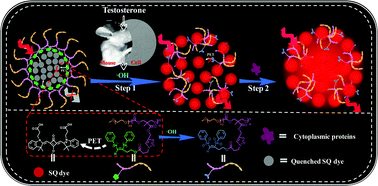Ultra-low background signaling cascade amplifiers for in vivo fluorescence imaging of hydroxyl radical production induced by testosterone†
Abstract
The designing of cascade assay strategies for sensing ultralow analyte concentrations is of crucial importance. However, the conventional strategies are not fit for in vivo detection due to the need to add assistant tools. To overcome the shortcomings, we constructed a signaling cascade amplifier using a poly(carbonate)s micelle-based nano container and a unique dye (SQ). As a proof-of-concept, a micelle-based nanoprobe, PMPC-2Se@SQ, was designed by decorating a selenium compound, a quenching agent and a recognition site, on the hydrophobic end of a poly(carbonate)s backbone, and wrapping the SQ-dye inside. The presence of ˙OH activates the recognition site and induces micelles destabilized, which release the multiple copies of the SQ-dye, generating primary fluorescence enhancement. Moreover, the released dyes can integrate cytoplasmic proteins to greatly amplify egotistical fluorescence signals, as secondary fluorescence enhancement. For the existence of this quadratic signal amplification mode, our strategy exhibited nearly 600 times fluorescence enhancement in cell lysates treated with ˙OH, with a detection limit of 2.8 pM. The feasibility of our methodology could sensitively detect the production mechanism of ˙OH in a stimulated pathway. It is hopeful that this novel strategy will open up new possibilities for tracing low-abundance biomarkers in the development of diseases.



 Please wait while we load your content...
Please wait while we load your content...